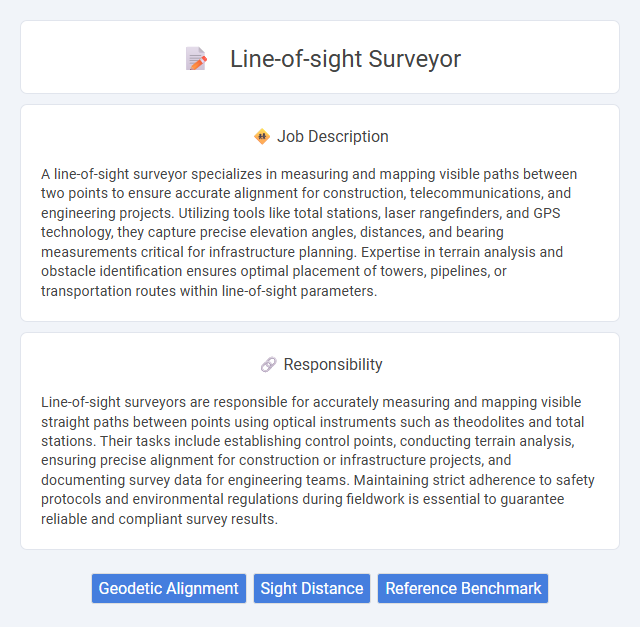
A line-of-sight surveyor specializes in measuring and mapping visible paths between two points to ensure accurate alignment for construction, telecommunications, and engineering projects. Utilizing tools like total stations, laser rangefinders, and GPS technology, they capture precise elevation angles, distances, and bearing measurements critical for infrastructure planning. Expertise in terrain analysis and obstacle identification ensures optimal placement of towers, pipelines, or transportation routes within line-of-sight parameters.
Line-of-sight surveyor roles likely suit individuals with strong visual acuity and good physical stamina, as the job typically requires long hours outdoors and precise observation skills. Candidates with a high tolerance for working in varying weather conditions and uneven terrains may have a higher probability of success. Those prone to motion sickness or discomfort in remote, rugged environments might find this job less suitable.
Qualification
Line-of-sight surveyors must possess strong knowledge of surveying equipment, including total stations, theodolites, and GPS technology, along with proficiency in interpreting topographic maps and blueprints. Candidates are typically required to have a degree or diploma in surveying, civil engineering, or a related field, complemented by certifications such as Certified Survey Technician (CST) or equivalent licenses. Experience in field data collection, precision measurement techniques, and familiarity with geographic information systems (GIS) further enhance their qualification for accurate and efficient line-of-sight assessments.
Responsibility
Line-of-sight surveyors are responsible for accurately measuring and mapping visible straight paths between points using optical instruments such as theodolites and total stations. Their tasks include establishing control points, conducting terrain analysis, ensuring precise alignment for construction or infrastructure projects, and documenting survey data for engineering teams. Maintaining strict adherence to safety protocols and environmental regulations during fieldwork is essential to guarantee reliable and compliant survey results.
Benefit
A Line-of-sight surveyor is likely to benefit from working in diverse outdoor environments, which can enhance job satisfaction through varied daily experiences. The role may offer opportunities for skill development in advanced surveying technologies, increasing career growth potential. This profession probably provides competitive compensation and job stability, especially in sectors like construction and telecommunications where precise line-of-sight measurements are crucial.
Challenge
Line-of-sight surveyor roles likely involve navigating difficult terrains and overcoming visibility obstacles, which could increase the complexity of data collection. The possibility of dealing with inclement weather conditions might further complicate ensuring accurate measurements. These challenges probably demand strong problem-solving skills and adaptability to maintain survey precision.
Career Advancement
Line-of-sight surveyors play a critical role in infrastructure projects by precisely measuring and mapping terrain to ensure clear visual paths for construction and communication systems. Career advancement in this field often leads to positions such as senior surveyor, project manager, or GIS specialist, where expertise in advanced surveying technology and data analysis is essential. Professional certifications like the Certified Survey Technician (CST) and proficiency in GPS and GIS software significantly enhance promotion opportunities and salary potential.
Key Terms
Geodetic Alignment
Line-of-sight surveyors specializing in geodetic alignment use precise instruments like total stations and GNSS receivers to measure and map straight-line paths between points with minimal error. Their work ensures the accurate positioning of infrastructure such as highways, railways, and pipelines by establishing reference markers aligned with geodetic coordinates. Proficiency in geospatial data analysis and knowledge of Earth curvature corrections is essential for maintaining survey accuracy on large-scale projects.
Sight Distance
Line-of-sight surveyors specialize in measuring and analyzing sight distance to ensure clear visibility for roadways, railways, and construction projects, optimizing safety and design accuracy. They utilize advanced tools such as total stations, laser rangefinders, and GPS technology to capture precise sight distance data critical for traffic flow and hazard prevention. Accurate sight distance assessment directly impacts engineering decisions, regulatory compliance, and transportation efficiency.
Reference Benchmark
A line-of-sight surveyor specializes in establishing precise visual bearings and reference benchmarks to enable accurate distance and alignment measurements in construction, engineering, and land surveying projects. Reference benchmarks serve as fixed points with known coordinates, providing a standardized frame of reference to ensure consistent and repeatable survey results over time. Mastery in utilizing optical instruments, GPS integration, and advanced software for setting and verifying these benchmarks is critical for maintaining the integrity of spatial data and project accuracy.
 kuljobs.com
kuljobs.com